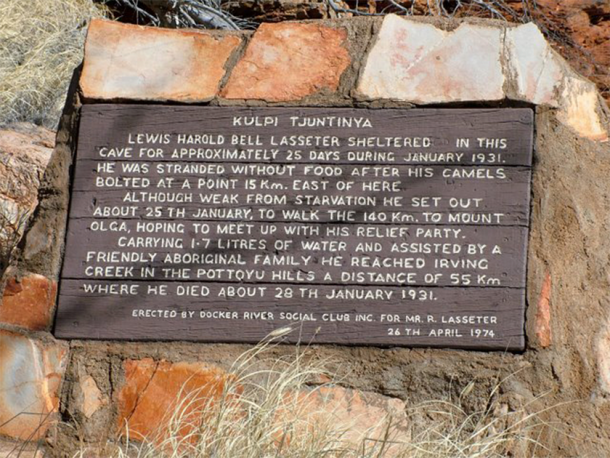
In the 18th and 19th centuries, the search for gold was at an all-time high. People discovered vast goldfields all across the world, attracting newcomers who wanted to try their luck. Gold miners and prospectors flocked to Alaska, Canada, Africa, and Australia. Some of them found wealth, while others found nothing at all. But some found more than they bargained for. They found the madness that the hunt for gold can create, the obsession with the promise of wealth. Harold Bell Lasseter was one such man, devoting his entire life searching for a fabled gold field in the heart of Australia. Was he a madman? Or does his story hide something we are yet to uncover?
The Story of the Fabled Lasseter’s Reef
Harold Bell Lasseter was a seemingly ordinary Australian man. He was born in Victoria in 1880, was self-educated, and known as a literate and well-spoken man. Not much about his life is known in great detail. He traveled to America on occasion, as well as across Australia , doing different jobs to make a living. It is also known he was married and had five children. During Australia’s involvement in the First World War, Lasseter had a history of going AWOL (absent without leave), and was discharged because of this. All in all, his life could have been rather unremarkable. But it wasn’t.

Harold Lasseter 1915, a few years before his first expedition for the gold reef. ( Public domain )
In 1929 and 1930, Lasseter – now a man of 50, made claims that in his youth, he discovered an exceptionally rich and vast deposit of gold, known as a reef. This alleged reef was located in Central Australia, on the western edge of the MacDonnell Ranges. The reef was supposedly unlike any other found before, and was incredibly rich with gold. Lasseter’s claims reached the government officials, and a geologist and a commissioner were sent to interview him. No further action was taken, however.
But Lasseter was not dismayed, and next reached out to the Australian Workers’ Union. This time, however, a slightly different account of his story was given. He claimed to have stumbled upon a huge gold-bearing reef when he was 17 years old, while he was riding a horse from Queensland to the West Australian gold fields. Upon discovery, however, he got “into difficulties”, and was luckily saved by a passing Afghan camel driver. When he returned to the area, he could not locate the reef. The area was at the time vast, unexplored Australian desert wilderness, where orientation is very difficult, even by today’s standards.

Lasseter claims of discovering a gold reef in Central Australia. ( Trung Nguyen /Adobe Stock )
A Golden Fable – or Golden Fact?
This time, Lasseter’s story attracted the attention of eager explorers. It was the Great Depression in Australia and finding sufficient funds for mounting an expedition was challenging. Either way, the Australian Workers’ Union was attracted by Lasseter’s tale, and his descriptions of gold “as thick as plums in a pudding”. He judged that “his” gold reef was worth £60 million ($72 million) at least – and that was a good motivator in the Great Depression era.
The Union set up a syndicate in Sydney in order to help fund the expedition. Within the first 24 hours, £5000 ($6000) was raised. In no time, this number reached £50,000 ($60000). The action was a success and finally Harold Bell Lasseter would be able to prove to the world that he was not a madman on a fool’s quest and that the now fabled “Lasseter’s Reef” was as real as can be.
The funding allowed Lasseter and the men of the Union to mount a decent expedition. The group numbered 7 men in total, with a powerful six-wheeler truck, and a plane as well. For the time, it was quite an elaborate setup. At his side, Lasseter had seasoned men that were ideal for the expedition. The crew included Lasseter as a guide, as well as a pilot, mechanic, driver, governor-general’s aide, crew leader, and a prospector. With such a crew, success was almost guaranteed. And so, on July 21st 1930, they began their quest to find Lasseter’s Reef.
But high spirits were extinguished almost instantly. Lasseter’s behavior became increasingly odd. He was in a sullen mood and gave only vague directions. The crew described him as “eccentric”, and increasingly uncooperative and suspicious. He began singing Mormon hymns, and spending long periods writing something in his diary. To make matters worse, the expedition was hampered by a string of misfortunes. The plane crashed twice and in the end was lost. Mechanical problems happened often, and the wilderness of the remote region was extremely difficult to traverse. In no time, the crew began to doubt the very existence of the fabled Lasseter’s Reef.
When Obsession Borders Sheer Madness
When the expedition finally reached Mount Leisler in the harsh Australian desert wilderness, Harold Bell Lasseter simply declared that they were 240 kilometers (150 mi) too far north of the intended search zone. The rest of the crew did not take this lightly. They were at the end of their composure, with Lasseter seemingly leading them on a fool’s trail. Absolutely angered, the expedition leader declared that Lasseter was nothing but a swindler and a charlatan, and ended the expedition then and there.
In no time, the crew parted ways with Lasseter, leaving him on his own – the reef now of no concern to them. Still, Lasseter was not troubled and decided to continue the search. His behavior, however, was increasingly eccentric and his obsession with Lasseter’s Reef guided him directly into madness. Yet he met with a passing dingo hunter, Paul Johns and his team of camels, and together they agreed to search for the reef, traveling towards the Kata Tjuta rock formations. Alas, Paul Johns too was quick to notice that something was not quite right with Lasseter.
One afternoon, he returned to camp bearing a concealed rock sample , saying to Johns that he re-discovered his fabled reef. However, he refused to reveal its location to Johns, which greatly angered the dingo hunter. A fight ensued, and in the end, Paul Johns abandoned Lasseter and declared him a lying madman, leaving him to his own devices.
Paul Johns was the last European to have seen Harold Bell Lasseter alive. He left Lasseter all alone, with just two camels to make his search easier. But nothing about it would be easy, since a lone man in the harsh Australian bush would have very slim chances of success. For the next 16 weeks, Lasseter made attempts to relocate his gold reef and to survive. He met with a wandering group of Aboriginal natives and spent some time with them. However, their meager rations were not enough to sustain him as well, and once more he was alone.
Holding Fast to an Idea – Even to the Last Breath
At one point, Lasseter’s camels fled, leaving him all alone in the vast desert, with absolutely no help. That was the moment that sealed his fate. Several months later, a search party discovered Lasseter’s emaciated remains. In his final days, he was severely malnourished and blinded, eventually dying from hunger and exhaustion. His body was discovered at the site called Winter’s Glen, while his personal belongings were found in a small cave at Hull’s Creek. Lasseter had kept a detailed diary, which he buried within the cave. The diary reveals his poignant thoughts and his very last moments on Earth. To the very last moment he was certain that he was on the brink of rediscovering Lasseter’s Reef, never losing hope.

Lasseter took shelter here for about 25 days during January 1931, when trying to find a rich gold deposit that he claimed to have discovered in the area. He recorded his account of his journey and was later found by a local Pitjantjatjara family. (Kendra Baker / CC by SA 4.0 )

Plaque at Kulpi Tjuntinya, Lasseter’s Cave, in Northern Territory, Australia. ( sallyseashells ( CC by SA 2.0 )
Somewhere along the line, weak and exhausted, Lasseter attempted to walk from the cave and reach Uluru, after realizing that no help was coming. This was a relatively close rock formation , also known as Ayers Rock. The sandstone formation rises steeply from the surrounding desert and is rich with freshwater springs, water holes, and rock caves. His trek was, however, a short one, and he died not far from the cave, alone and emaciated. His diary remains as a very striking and sad glimpse into this man’s troubled mind, and his realization that no help was coming, and that he was all on his own. He waited desperately for supplies and help, wrote of his love for his wife and children and his concerns for them, and his close encounters with death.
The quest for Lasseter’s Reef ended all too soon and in a tragic way. Harold Bell Lasseter was buried with dignity, and his story was quickly popularized. Many – or most – thought that his story was pure madness, even though the man’s diary said otherwise. In many ways, Lasseter took his secrets with him to the grave, leaving us only to speculate in vain.
In 1931, not even a year after Lasseter died, Australian writer Ion Idriess purchased his diary for £25, from his widow. He used it as a source material for writing his best-seller, “Lasseter’s Last Ride”. The book was an instant success and was reprinted 17 times in the following four years.
A Man That Left Many Mysteries
In the years following his death, Harold Bell Lasseter became the source of many enigmas. It was discovered that his actual birth name was Lewis Hubert Lasseter. In 1924, however, he added “Harold Bell” to his name. It is likely that he took this from the name of writer Harold Bell Wright, who published his book “The Mine with the Iron Door” in 1923. And, most interestingly, this book’s central topic is a lost gold reef..
That is not the only mystery. Over the years, Lasseter made some odd claims. He presented himself variously as a ship’s captain, a prospector, surveyor, and even as the designer of the Sydney Harbor bridge. Could it be that he was, in fact, an actual madman? A swindler who wanted to dupe an entire continent? Or was he simply an eccentric man who firmly believed in his lost gold reef? Whatever the truth, we might actually never know it.
The story of the Lasseter’s Reef quickly became a sensation in Australia. The story gained mythical proportions and many eager prospectors attempted to discover the reef – with no success. Several movies were made based on the story, and even today, almost a century later, the story captivates the imagination of all Australians.
Was Harold Bell Lasseter a Misunderstood Man?In the end, the story remains a mystery. But we have to pose a question: was Harold Bell Lasseter a gravely misunderstood man? Was he judged too quickly and abandoned before his quest could be realized? In the decades after his death, many have asked this question, but the answer could not be found.
The only answer to this enigma is Lasseter’s Reef itself. Finding it would come as a final exclamation mark to the whole wild story of Harold Bell Lasseter. But to date, no “exceptionally rich gold reef”, where gold was “as thick as plums in a pudding” has been discovered in Australia.
source: https://www.ancient-origins.net







